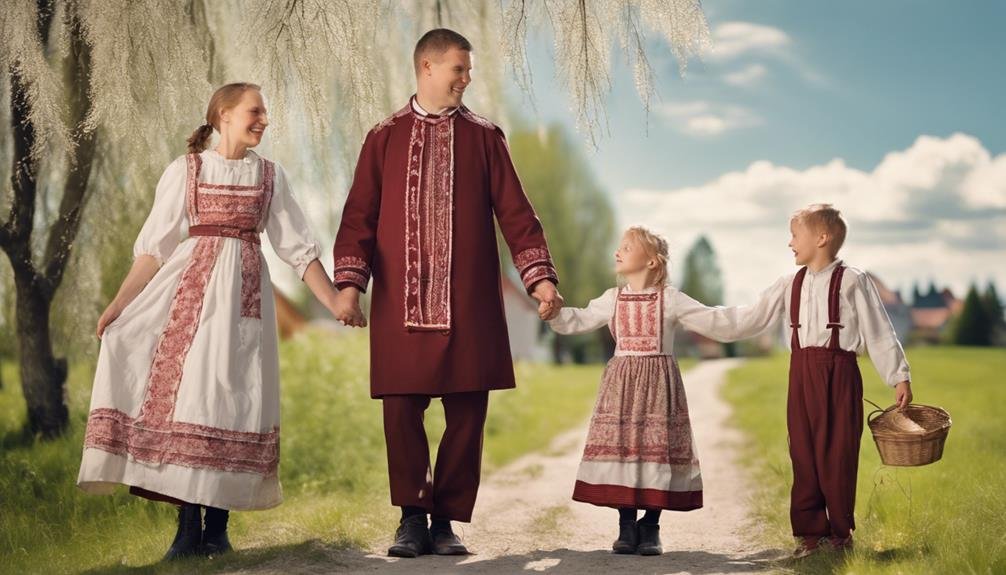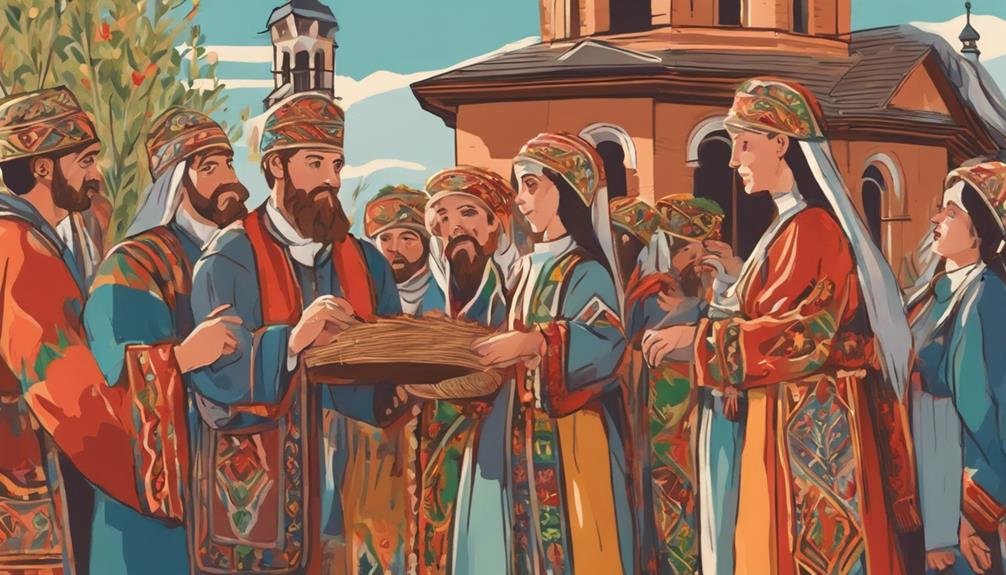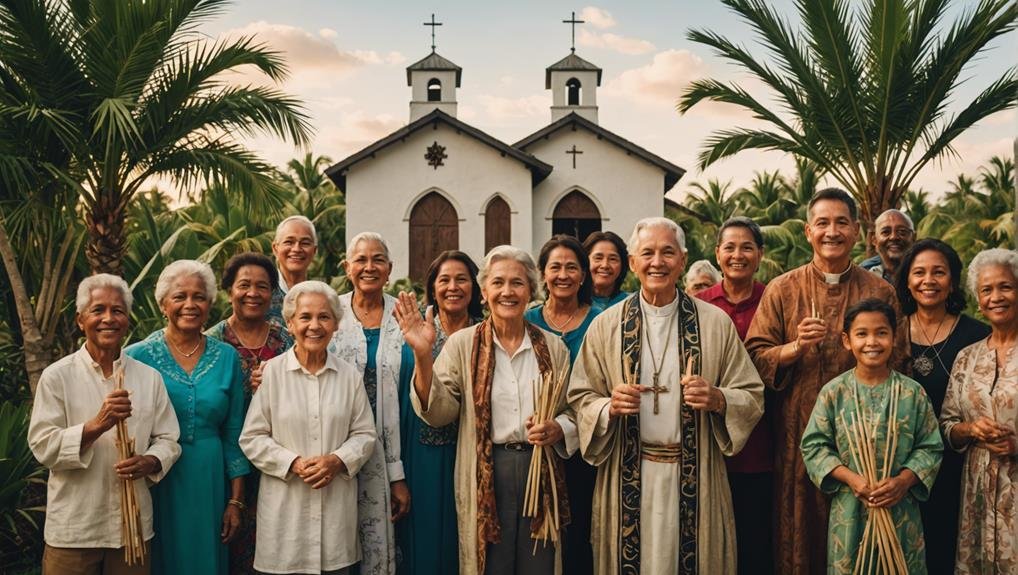As you explore the diverse ways Palm Sunday Traditions is celebrated around the world. You’ll discover a fascinating blend of rituals that not only mark the beginning of Holy Week but also reflect each culture’s unique heritage. From the willow branches used in Poland to the vibrant palm frond processions in the Philippines. Each tradition carries its own symbolic meaning and offers a glimpse into the local community’s spiritual life. The intricate customs and the stories behind them might make you wonder. How these practices compare to those in other parts of the globe and what they reveal about the universal themes of renewal and faith.
Key Takeaways
- Explore local customs, such as willow branches in Poland or palm fronds in the Philippines, to embrace regional Palm Sunday traditions.
- Participate in community processions or blessings to experience the communal and religious aspects of Palm Sunday.
- Create or purchase decorated palms, crosses, or wreaths as used in countries like Bulgaria and Latvia to understand cultural expressions.
- Engage with cultural heritage by attending or observing competitions and artistic displays linked to Palm Sunday in various countries.
- Reflect on the themes of awakening, renewal, and triumph central to Palm Sunday celebrations globally to deepen the spiritual experience.
Poland: Willow Sunday
Have you ever wondered how Palm Sunday is celebrated in Poland, where traditional pussy willow branches, known as baize kotki, take center stage? In Poland, this day is referred to as Willow Sunday, a nod to the crucial role these branches play. With the country’s spring starting later, locals place these branches in water until they sprout lush green buds. These aren’t just any sprigs; they’re festively adorned with birch, currant, boxwood, and colorful ribbons, transforming them into vibrant symbols of the season.
During Willow Sunday, you’d witness competitions that showcase these decorated palms. Communities come together to vie for titles like the tallest and most beautifully decorated palm. It’s not just a small-town affair. Some of these creations soar over 30 meters high, turning the event into a breathtaking spectacle. Imagine walking through streets lined with these towering, ornate palms, each a reflection of local craftsmanship and communal spirit.
This tradition isn’t merely about displaying artistic palms; it’s a profound communal expression of faith and anticipation for the renewal spring promises.
Philippines: Palm Frond Processions
In the Philippines, you’ll find devotees holding intricately woven palm fronds during Palm Sunday mass. These palm fronds, known as palaspas, are more than just decorative items; they’re a deep-rooted part of the Palm Sunday traditions in this vibrant country. Crafted into various shapes, each palaspas is a work of art, symbolizing triumph and blessings.
As you wander through the streets of Manila, the buzz of the Palm Sunday celebrations is unmistakable. The air is filled with a sense of reverence and festivity as people flock to churches with their palaspas. Here, the fronds are blessed by priests, a ceremony that’s believed to bring luck and protection to homes where the palaspas are later displayed.
This tradition isn’t just a beautiful spectacle; it’s a meaningful expression of faith and cultural identity. It connects generations, with skills in weaving the palaspas often passed down through families. Whether you’re a local or a visitor, participating in or observing this ritual gives you a richer appreciation of the Filipino spirit and devotion.
Norway: Cross Processions

While the Philippines celebrates with palaspas, Norway embraces Palm Sunday with its unique cross processions. You’ll find yourself surrounded by locals carrying beautifully decorated crosses, each detailing a special touch of personal faith and tradition. These cross processions are a profound expression of religious devotion, weaving through villages and towns, creating a sense of community and shared belief.
In addition to the processions, Norwegians decorate their homes with birch twigs and painted eggs, infusing their living spaces with symbols of new life and renewal typical of the season. These birch twigs aren’t just décor; they symbolize the spirit of Palm Sunday, intertwining nature with spirituality in the comforts of home.
The week leading up to Easter, often free from work, is rich with family traditions. It’s a perfect time for you to engage in skiing, a favored Norwegian activity, allowing both reflection and exhilaration against snowy landscapes. This period is also ideal for reconnecting with loved ones, perhaps over reading sessions or crafting painted eggs with the kids, making each moment count.
In Norway, Palm Sunday isn’t just a day, but a heartfelt start to Holy Week, filled with unique customs that blend reverence with the joy of family gatherings.
The Netherlands: Blessing Branches
Children in the Netherlands celebrate Easter by carrying crosses adorned with ribbons and a bread rooster atop. This unique tradition captures the festive spirit of Easter in the region. The rooster, not just a simple decoration, symbolizes awakening and rejuvenation, themes deeply embedded in Easter celebrations. In the Netherlands, the use of roosters, rather than the more common chicks and eggs, highlights a distinct cultural interpretation of the holiday.
During Palm Sunday, these symbolic elements come into play vividly. You’ll find that branches, blessed in various ceremonies, also hold a significant place in the Dutch observance of this day. The branches aren’t just any branches. They’re carefully chosen and often intertwined with the vibrant ribbons that also grace the crosses. This intertwining of nature and crafted symbols beautifully represents the renewal that Palm Sunday heralds.
In some Dutch towns, processions during this time feature these adorned crosses prominently, with community members of all ages participating. It’s a sight that ties the community together, emphasizing shared traditions and collective celebration. As you witness these processions, you’re not just observing a ritual. You’re experiencing a living, breathing part of the Netherlands’ cultural heritage.
Latvia: Pussy Willow Day

Latvia celebrates Pussy Willow Day, where parents gently wake their children with playful swats from willow branches. This unique tradition is a beloved part of Latvia’s Easter celebrations, symbolizing the arrival of spring and the resurrection of Jesus. Unlike other regions where palm branches are common, in Latvia, pussy willows are much easier to find and therefore become central to their Palm Sunday celebrations.
Here’s what makes Pussy Willow Day in Latvia so special:
- Symbolic Awakening: The gentle swatting with willow branches is meant to awaken not just from sleep but to a season of renewal and growth, echoing the resurrection theme of Easter.
- Crafting Traditions: Latvians weave the flexible willow branches into intricate rings and other shapes, showcasing their artistic skills and adding a communal activity to the celebration.
- Natural Adaptation: Due to the scarcity of palm branches, the adaptation to use locally abundant pussy willows highlights the resourcefulness and cultural uniqueness of Latvian Palm Sunday celebrations.
- Furry Catkins: The soft, furry catkins of pussy willows are particularly associated with this holiday, believed to bring health and prosperity.
This celebration not only honors religious traditions but also fosters a deep connection with nature and community in Latvia.
Haiti: Rara Festival
In Haiti, the Rara Festival vividly merges Catholic and Voodoo traditions during Palm Sunday celebrations. You’ll witness a vibrant display where spiritual practices intertwine uniquely, reflecting the island’s rich cultural tapestry. As you walk through the lively streets, you’re enveloped by the sounds of drums, maracas, and trumpets. Each expression a testimony to a long-standing tradition that celebrates both rebirth and ancestral memories.
Palm fronds sway not just in the breeze but as integral decorations, symbolizing peace and triumph, essential themes of Palm Sunday. The music, central to the festivities, isn’t just background noise. It’s a dynamic, pulsating force that brings together communities and connects the physical to the spiritual.
The Rara Festival isn’t just a day. It’s a profound experience where you see, firsthand, how Haiti honors its dual heritage. Catholic icons are carried alongside Voodoo symbols, each step of the procession a dance of coexistence and mutual respect. Here, faith isn’t confined to a single doctrine but is a vibrant celebration of life, resilience, and unity. So, immerse yourself in this unique festival, where every note played and every palm waved tells a story of survival and coalescence.
Finland: Virpominen Traditions

While Haiti’s Rara Festival showcases a blend of cultural and spiritual practices. Finland celebrates Palm Sunday with its unique Virpominen tradition, where young Easter witches playfully exchange willow branches for treats. This charming Finnish custom adds a whimsical touch to the solemnity of Palm Sunday, blending local folklore with religious observance.
In this tradition, children throughout Finland eagerly dress up as witches, complete with colorful scarves, painted faces, and broomsticks. They go door-to-door, reciting traditional rhymes that promise health and happiness in exchange for sweets. Here’s what you need to know about the Virpominen tradition:
- Costumes and Creativity: Kids use their imagination to create vibrant and intricate costumes that bring the Easter witch characters to life.
- Willow Branches: The branches, symbolizing new life and the coming of spring, are decorated with feathers and ribbons, transforming them into magical wands.
- Exchange Ritual: At each door, children recite specific poems and offer their decorated branches in hopes of receiving candy or small treats.
- Community and Joy: This festive event fosters a sense of community and joy among neighbors, enhancing the celebratory atmosphere of Easter and Palm Sunday in Finland.
Embrace this delightful tradition where children, tradition, and the festive spirit of Easter converge to create unforgettable memories!
Ethiopia: Hosanna Day
Celebrating Hosanna Day, Ethiopian Christians skillfully weave palm fronds into elaborate rings to honor this significant occasion. As you immerse yourself in this vibrant celebration, you’ll notice the central role that palm leaves play in the festivities. In Ethiopia, the presence of these intricately crafted rings isn’t just decorative. It’s deeply symbolic, embodying the spirit of Hosanna Day.
On this day, you’d find groups of women gathering outside churches. Their hands busy crafting these symbols of faith and devotion. The air buzzes with excitement and a sense of communal bond. The term ‘Hosanna’ resonates through the crowd, a powerful reminder of the day’s religious significance.
As you join in, you’ll feel the unity and joy that Hosanna Day brings to communities across Ethiopia. It’s more than just a religious observance. It’s a day where culture and faith intertwine beautifully through music, prayer. The shared act of creating elaborate rings from palm leaves. This celebration is a profound expression of Ethiopian heritage. Where every woven ring and echoed ‘Hosanna’ enriches the collective spirit of the occasion.
Bulgaria: Tsvetnitsa Celebrations

As you explore further, you’ll discover that Tsvetnitsa in Bulgaria also embraces unique springtime traditions with its use of willow branches and flowers. This celebration, synonymous with Palm Sunday in Bulgaria, is popularly known as Flower Day. Here, the festivities are marked by a beautiful blend of religious observance and cultural expression that highlights the arrival of spring.
On Tsvetnitsa, Bulgarians engage in several customs:
- Gathering Willow Branches: People collect willow branches, symbolizing new beginnings and protection.
- Making Wreaths: Families craft intricate wreaths from pussy willows and vibrant flowers, which are then used to decorate homes and churches.
- Blessing Ceremonies: These wreaths are often taken to churches to be blessed, intertwining spiritual significance with cultural tradition.
- Hosting Family Dinners: The day concludes with large family dinners, where loved ones gather to share meals and celebrate the season together.
This fusion of floral beauty with communal gatherings not only makes Tsvetnitsa a visually stunning occasion. A heartwarming opportunity to reconnect with family and tradition. You’ll find that in Bulgaria, Tsvetnitsa is much more than just Palm Sunday. It’s a heartfelt celebration of community and renewal.
How Can Family Activities Enhance the Experience of Celebrating Palm Sunday Traditions Globally?
Participating in Palm Sunday traditions as a family fosters unity and shared joy. From creating palm frond crafts to attending services together, these activities serve as excellent family bonding ideas. Engaging in meaningful rituals enhances cultural appreciation and strengthens connections, making the celebration more memorable across generations.
What Are the Global Traditions of Celebrating Palm Sunday?
In Brazil palm Sunday church services hold a significant place in the Christian tradition. It is celebrated worldwide with reverence and joy, marking the beginning of Holy Week. People attend mass, carrying palm branches to symbolize Jesus’ triumphal entry into Jerusalem. The vibrant processions and Gospel readings recount the biblical event, fostering a sense of devotion and unity among believers. Brazil’s rich cultural heritage adds a distinct flavor to these services, making palm Sunday a cherished occasion for Brazilian Christians.
Belgium: Palm Blessings
In Belgium, you’ll find that children play a pivotal role in Palm Sunday traditions by going door-to-door to offer palm leaves in exchange for coins. This custom not only enriches the festive spirit but also deeply ingrains the value of sharing and community in young minds. As you wander through Belgian towns, you’ll witness these vibrant palm blessings where the laughter and joy of children fill the air.
Here’s a quick glance at how palm blessings unfold:
| Action | Description |
|---|---|
| Children Gather | Groups of children collect palm leaves. |
| Door-to-Door | They visit neighbors, offering leaves for coins. |
| Palm Blessings | Clergy bless the leaves during church services. |
| Community Bonding | The exchange fosters a sense of community. |
This tradition is not just about the exchange of palm leaves and coins. It’s a meaningful interaction that strengthens bonds and celebrates the season. The processions in some towns add a communal prayer dimension, enhancing the spiritual experience. Whether you’re a local or a visitor, participating in or observing these rituals offers. A profound glimpse into Belgian cultural heritage and the universal themes of goodwill and renewal that Palm Sunday embodies.
Conclusion
As you explore these diverse Palm Sunday traditions, you’ll discover a world of rich cultural heritage and deep spiritual significance.
From the willow-laden celebrations of Poland to the solemn palm frond processions in the Philippines, each tradition offers a unique way to welcome Holy Week.
Whether you’re weaving palms in Belgium or joining cross processions in Norway, embrace these moments of renewal and community.
Enjoy the festive spirit and continue the beautiful legacy of these global customs.

